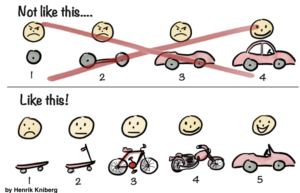The “MVP” term can be heard a lot this day but not many people know exactly what it is and why it is so important. So first, let’s define what MVP means and then we will explain, why MVP implementation is vital for any startup (or huge company as well).
According to Wikipedia, minimum viable product (MVP is a product with enough set of features so the user can gather validated learning about the product and its further development. In other words, it can be compared to a product preview or demo: MVP gives an idea of what the product is going to be like at the end of the development process, and more features and value are going to be added until the product is complete. So if you have the certain idea and want to check how it will turn out and how users will react to it, then MVP is your choice.
Example:
If you want to build a car, then bicycle would be its MVP. It allows users to ride on it, it vaguely reminds of a car but you have to add more features to the bicycle in order to have a fully-functioning car.

This image helps to understand the MVP concept. MVP should not be considered as part of the final product: it is already a product, ready to be used. In addition, MVP also brings value on the stand-alone basis, however, further changes are needed to 100% satisfy the customer. So during each development stage, you keep adding value until the product is complete and the customer is happy with it.
Also Check: 9 ways to create Marketing Demand for your unknown Startup
Keep in mind that you have to have a clear purpose in order to use MVP. It takes time and planning to be launched. Be sure you know your metrics that will help you in tracking and targeting.
The main mistake that many startups make: they spend a lot of resources and effort that give zero results in the end. The reason is – startups do not get any feedback from the users and launch the project, without really knowing whether it will satisfy the user or not. MVP helps to avoid this because you are learning from your potential users during the development process, and it allows you to timely react to any negative comments and fix the problem.
Before launching your MVP, you have to have a clear idea and vision of a final product, technical plan of implementation and clear understanding of your target audience and necessary key metrics.
Do not overload your MVP with too many features. However, don’t be afraid to get rid of anything that seems useless or not important.
Remember the main MVP idea: testing its concept, but not over-complicating it. This explains how MVP saves time and effort – it simply requires little time and a few resources for the development of basic features.
Do not underestimate teamwork: it will allow you to come up with a clear target and reach it in time.
It’s always good to dream big, but for a start, you will need the reachable and understandable target. Develop an achievable way of launching your product and create a list of indicators (conversion rate, an amount of website visitors) that will show the viability of your product.
Since MVP is not a fully completed project, you don’t have to invest in fancy UI and design. For the MVP stage, the product just has to look good and perform basic functions.
The idea behind any MVP is clarity and simplicity. It means that MVP has the minimal and necessary set of functions, which gives users validated learning about the product. So you have to put functionality before fancy design. Of course, your MVP should still look attractive because you need to interest your users. Friendly and clear UI and logic of usage should be enough and in addition, it will save your money.
Instead of investing into the complex design, save your budget for marketing campaigns. You will need real people for MVP testing, so do your best to attract people. Remember: there are hundreds of startups, but only a few of them grow into the serious business.
But again, with MVP you don’t need to create huge marketing campaigns and promotion. As soon as you have MVP, introduce it to the users. And if prototype satisfies them, it will give you a chance to attract investors and turn your minimum viable product into a full-scale project.
Launch earlier, fail earlier, learn and repeat.
Do not waste time. In the business world, the winner is the one who acts fast and is not afraid to make mistakes. And the sooner you launch your product, the sooner you fail or get any feedback, which means you will have time to fix it and repeat as many times as needed until your user is 100% satisfied.
dashBOUQUET is an agency which develops web and mobile apps, provides iOS and Android development services.






Comment here